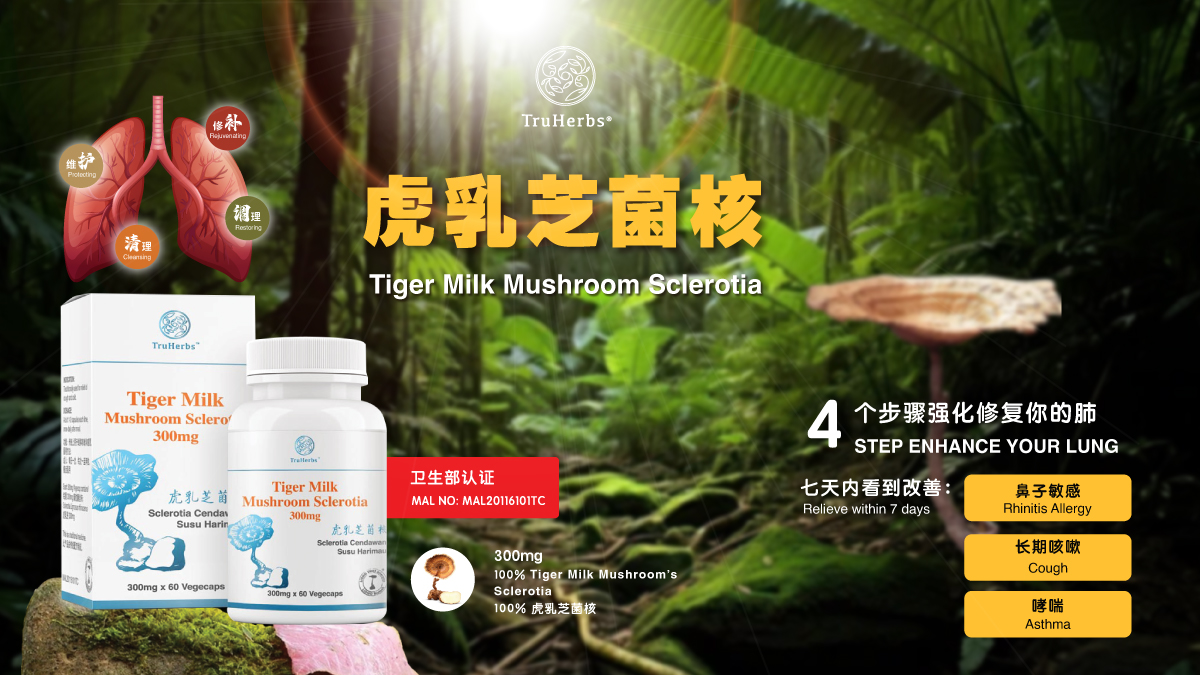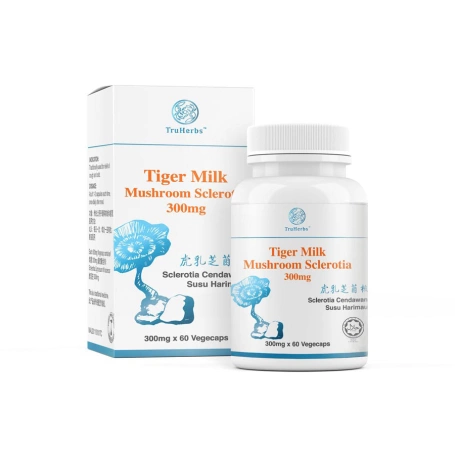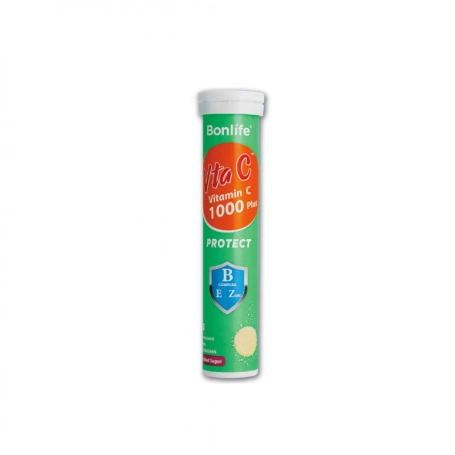The Difference Between Flu and Common Cold: A Health Guide for Malaysia

In Malaysia, despite the lack of winter, the fluctuation of seasons and weather changes can still lead to a rise in flu and common cold cases. Particularly during the rainy season or when the climate becomes hot and humid, viruses are more easily transmitted, especially in densely populated areas. Understanding the difference between flu and the common cold, along with knowing the right methods of prevention and treatment, can effectively help us manage this health challenge. This article will discuss in detail the symptoms, diagnosis, and treatment differences between the flu and the common cold, and will provide traditional Chinese medicine (TCM) remedies. Additionally, we will recommend health supplements suitable for boosting immunity, such as TruHerbs Tiger Milk Mushroom and Bonlife VTA-C Protect Vitamin C Effervescent Tablets, to help everyone maintain their health.
Symptoms of the Flu
Flu is a highly contagious respiratory illness caused by the influenza virus. It usually occurs suddenly, and its symptoms are more severe than those of a common cold. The typical symptoms of the flu include:
- High Fever: Body temperature can quickly rise to 39°C or higher and usually lasts for 3 to 4 days.
- Body Aches: Muscle and joint pain are common, particularly in the back, arms, and legs.
- Extreme Fatigue: Flu can cause intense fatigue that may last for several weeks.
- Dry Cough: Flu often brings a severe dry cough, often accompanied by throat discomfort.
- Chills and Sweating: Shivering and sweating are typical flu symptoms.
- Sore Throat: A sore throat often accompanies the cough.
- Headache: Severe headaches are common among flu sufferers.
- Gastrointestinal Symptoms: Particularly in children, flu may cause nausea, vomiting, or diarrhea.
Symptoms of the Common Cold
The common cold is usually caused by viruses like rhinoviruses. Its symptoms are milder than the flu and develop more gradually. Common cold symptoms include:
- Runny or Stuffy Nose: The most common symptom of a cold.
- Mild Fever: Adults typically do not have a fever, but children may develop a low-grade fever.
- Sore Throat: A mild sore throat is common in the early stages of a cold.
- Sneezing: Frequent sneezing is a hallmark of the common cold.
- Mild Cough: Coughing tends to be mild and may be accompanied by a small amount of mucus.
- Mild Headache: Headaches occur in some cases but are not as intense as flu-related headaches.
- Mild Fatigue: Although a cold may cause some tiredness, it is not as overwhelming as the fatigue caused by the flu.
Key Differences Between Flu and the Common Cold
While flu and the common cold both present respiratory symptoms, there are significant differences in terms of the speed of onset, severity, and potential complications:
| Aspect | Flu | Common Cold |
|---|---|---|
| Onset | Symptoms develop rapidly | Symptoms develop gradually |
| Severity | High fever, body aches, and extreme fatigue | Mild symptoms, such as runny nose and cough |
| Complications | Can lead to severe complications like pneumonia or bronchitis | Rarely causes severe complications |
| Duration | Symptoms last 1-2 weeks; fatigue may last longer | Symptoms generally last 7-10 days |
Diagnosis and Treatment of Flu and Common Cold
Diagnosis: The flu is diagnosed by testing for the influenza virus through a nasal or throat swab. Early diagnosis is especially important for high-risk groups, such as the elderly, children, pregnant women, and those with weakened immune systems.
Antiviral Medications: Medications like oseltamivir (Tamiflu) can shorten the duration of flu symptoms and reduce the risk of complications but must be administered within 48 hours of symptom onset.
Symptomatic Treatment: This includes using fever reducers, cough suppressants, and pain relievers.
Rest and Hydration: Adequate rest and fluid intake are essential for recovery.
Diagnosis and Treatment of the Common Cold
Diagnosis: The common cold is typically diagnosed through symptoms evaluation, and additional tests are rarely needed.
Treatment:Decongestants: These help to relieve nasal congestion.
Cough Suppressants and Antihistamines: These can help reduce coughing and sneezing.
Over-the-Counter Pain Relievers: Medications like ibuprofen or acetaminophen can help alleviate headaches and sore throats.
How to Prevent the Flu?
- Get the Flu Vaccine: Annual vaccination is the best way to prevent the flu, especially during flu season.
- Practice Good Hygiene: Regular hand washing and maintaining clean surroundings can help prevent the spread of the virus.
- Strengthen the Immune System: A healthy lifestyle, including a balanced diet, regular exercise, and sufficient sleep, can help boost the immune system.
- Avoid Contact with Infected Individuals: During the flu season, avoid close contact with those who have flu symptoms.
How to Prevent the Common Cold?
- Wash Hands Frequently: Keeping hands clean and avoiding touching the face reduces the chance of infection.
- Stay Hydrated: Drinking plenty of water helps alleviate cold symptoms.
- Avoid Overexertion: Adequate rest allows the body to fight off viruses more effectively.
Traditional Chinese Medicine (TCM) Remedies for Flu and Common Cold
According to TCM, flu and the common cold are categorized as external wind-cold or wind-heat conditions. TCM treatments focus on dispelling wind and cold or clearing heat and toxins, depending on the symptoms.
Common TCM Remedies
- Wind-Cold Common Cold: Formulas like Jing Fang Bai Du San or Gui Zhi Tang are used to disperse cold and release the exterior, relieving symptoms such as chills, fever, headache, and nasal congestion.
- Wind-Heat Common Cold: Yin Qiao San or Sang Ju Yin can be used to clear heat and relieve toxins, suitable for treating sore throat, yellow nasal discharge, and fever.
Tea Therapy Recommendations
- Ginger and Red Date Tea: Ginger helps dispel cold, and red dates boost qi and nourish the blood, making this tea ideal for those with wind-cold symptoms.
- Honeysuckle Tea: Honeysuckle has heat-clearing and detoxifying properties, perfect for alleviating sore throats and fever.
- Chrysanthemum and Goji Berry Tea: Chrysanthemum clears heat and reduces headaches, while goji berries nourish the body and soothe eye discomfort.
Acupuncture Therapy
Acupuncture can stimulate specific points in the body to regulate qi and blood circulation, thus helping to alleviate flu or cold symptoms. Common acupuncture points include Fengchi (GB20), Hegu (LI4), and Yingxiang (LI20), which are effective for relieving headaches, nasal congestion, and body aches.
Benefits of TCM in Treating Flu
In recent years, studies have increasingly demonstrated the following benefits of using TCM to treat flu:
- Faster, More Stable, and Long-Lasting Fever Reduction: TCM's ability to reduce fever, particularly using traditional formulas such as Yin Qiao San, Ma Xing Shi Gan Tang, Xiao Chai Hu Tang, and Da Yuan Yin, has proven effective in clinical practice. Many elderly TCM doctors have accumulated experience in treating flu with these ancient remedies, and modern research provides increasing evidence supporting these treatments.
- Effective Relief of Sore Throat and Body Pain: TCM does not only target the disease but also treats specific symptoms like sore throat and body aches. TCM identifies the cause of these symptoms—whether wind-cold or wind-heat—and applies targeted therapies accordingly, showcasing the advantage of multi-target treatment.
- Reduced Incidence of Post-Flu Cough: When TCM treatments are applied early, they can effectively minimize or even prevent the development of a cough after the flu.
- Better Outcomes for Severe Cases: In severe or critical cases, combining TCM with Western medicine can help reduce the need for antibiotics, mechanical ventilation, and can lower mortality rates.
Recommended Health Supplements: Boosting Immunity and Respiratory Health
To better strengthen the immune system and improve respiratory health, the following two health supplements are recommended:

TruHerbs Tiger Milk Mushroom
- Ingredients and Benefits: Made from the patented Ligno TM02®️ variety of Tiger Milk Mushroom, each capsule contains 300mg of pure Tiger Milk Mushroom sclerotia. The concentration of Tiger Milk Mushroom in TruHerbs is five times higher than that of standard food-grade products on the market. Known for its potent immune-boosting and anti-inflammatory properties, Tiger Milk Mushroom is particularly suitable for enhancing respiratory function and immunity.
- Key Benefits:
- Patented Ligno TM02®️ Tiger Milk Mushroom, 300mg of pure sclerotia per capsule.
- Effectively protects respiratory health.
- Strengthens immunity and alleviates respiratory issues.
- High concentration, five times stronger than standard food-grade products.
Bonlife VTA-C Protect Vitamin C Effervescent Tablets
- Ingredients and Benefits: Each tablet contains 1000mg of high-potency Vitamin C, specially designed to enhance the immune system. The effervescent tablet form allows for rapid dissolution and absorption, making it ideal for supporting the body’s defense against colds, flu, and other viral infections.
- Key Benefits:
- Each tablet contains 1000mg of Vitamin C, boosting immunity effectively.
- Supports the body in fighting colds, flu, and viral infections.
- Effervescent form dissolves quickly and is easily absorbed.
- Suitable for daily supplementation to enhance overall health.
Frequently Asked Questions
What are the main differences between flu and the common cold symptoms?
Flu symptoms are typically more severe, including high fever, body aches, and extreme fatigue, while the common cold mostly involves milder symptoms like a runny nose, sore throat, and mild fatigue.
How can you quickly differentiate between flu and a common cold?
Flu symptoms appear suddenly and are more intense, whereas cold symptoms develop gradually and are less severe. Flu usually causes high fever and extreme tiredness, while colds result in mild discomfort.
What are the treatment options for the flu?
Flu can be treated with antiviral medications like oseltamivir, which must be taken early, whereas treatment for the common cold is focused on symptom relief as there is no antiviral drug to shorten the duration of a cold.
What preventive measures are effective?
Getting vaccinated annually is the most effective way to prevent flu, while frequent hand washing and good hygiene can help prevent the common cold.
What are the advantages of using TCM to treat the flu?
TCM offers quick and long-lasting fever reduction, relieves sore throat and body pain, and can prevent or reduce post-flu coughs. In severe cases, combining TCM with Western medicine can improve outcomes.
How can you protect yourself and your family during the flu season?
Regular flu vaccinations, boosting immunity, practicing good hygiene, and avoiding contact with infected individuals are the best ways to protect yourself and your family.
Conclusion
While Malaysia does not have a winter season, flu and the common cold still pose significant health threats, especially during seasonal changes. By understanding the differences between their symptoms, diagnosis, and treatment methods, and by incorporating traditional Chinese medicine and appropriate health supplements like TruHerbs Tiger Milk Mushroom and Bonlife VTA-C Protect Vitamin C Effervescent Tablets, we can better protect our health during flu season.

 Bahasa melayu
Bahasa melayu 中文
中文

























